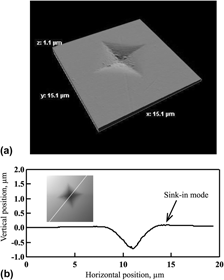Article contents
Use of an atomic force microscope for the metrological verification of the reference standards of instrumented indentation tests
Published online by Cambridge University Press: 27 September 2011
Abstract

Availability of atomic force microscope (AFM) is discussed in the point of view of the measurement standard. For indenter geometry verification in the pyramidal part, the fully mathematical method, Regression Polyhedral Model, is used to avoid the effects of human factors and the misalignment of the indenter axis. As an example, facet angles, angles between opposite faces, and the interior angles of the square base of pyramid of a Vickers indenter are analyzed to demonstrate the efficiency of this method. The area function of the indenter is also calculated as an analytical result of AFM image. The procedure of uncertainty of measurement of those geometrical parameters is developed. For geometrical parameters of pyramid, the uncertainty can be estimated by combining the resolution and linearity of the AFM, the effect of the scanning tip, the uncertainty of the reference standard used to calibrate the AFM, and the regression error which includes flatness and roughness of the pyramid faces; and for the uncertainty of the area function, the uncertainty of AFM coordinates are taken into account. The results show that the uncertainty of facet angles and angles between opposite faces is small; but on the other hand, the uncertainty of the interior angles of square base of pyramid is not negligible. The uncertainty of the area function is almost proportional to the contact depth, but the relative uncertainty is exponentially increased where the contact depth is small. In addition, the observations of indents are shown to verify the indentation hardness HIT of the certified reference materials (CRMs) by comparing with Vickers hardness determined with AFM observations. Through those examples, the possibility to improve certified values of CRMs is suggested.
- Type
- Articles
- Information
- Journal of Materials Research , Volume 27 , Issue 1: Focus Issue: Instrumented Indentation , 14 January 2012 , pp. 294 - 301
- Copyright
- Copyright © Materials Research Society 2011
References
REFERENCES
- 1
- Cited by




